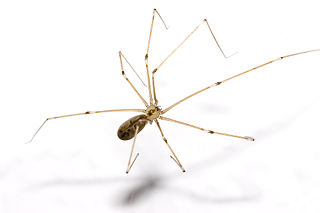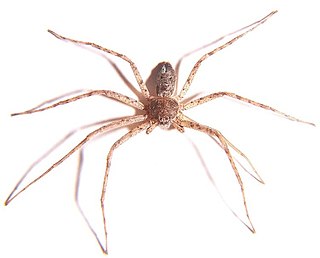
The subphylum Chelicerata constitutes one of the major subdivisions of the phylum Arthropoda. Chelicerates include the sea spiders, horseshoe crabs, and arachnids, as well as a number of extinct lineages, such as the eurypterids and chasmataspidids.

Arachnids are arthropods in the class Arachnida of the subphylum Chelicerata. Arachnida includes, among others, spiders, scorpions, ticks, mites, pseudoscorpions, harvestmen, camel spiders, whip spiders and vinegaroons.

The Mygalomorphae, or mygalomorphs, are an infraorder of spiders, and comprise one of three major groups of living spiders with over 3,000 species, found on all continents except Antarctica. Many members are known as trapdoor spiders due to their creation of trapdoors over their burrows. Other prominent groups include Australian funnel web spiders and tarantulas, with the latter accounting for around one third of all mygalomorphs.

Huntsman spiders, members of the family Sparassidae, catch their prey by hunting rather than in webs. They are also called giant crab spiders because of their size and appearance. Larger species sometimes are referred to as wood spiders, because of their preference for woody places. In southern Africa the genus Palystes are known as rain spiders or lizard-eating spiders. Commonly, they are confused with baboon spiders from the Mygalomorphae infraorder, which are not closely related.

Ctenizidae is a small family of mygalomorph spiders that construct burrows with a cork-like trapdoor made of soil, vegetation, and silk. They may be called trapdoor spiders, as are other, similar species, such as those of the families Liphistiidae, Barychelidae, and Cyrtaucheniidae, and some species in the Idiopidae and Nemesiidae. The name comes from the distinctive behavior of the spiders to construct trapdoors, and ambush prey from beneath them.

The Pholcidae are a family of araneomorph spiders. The family contains more than 1,800 individual species of pholcids, including those commonly known as cellar spider, daddy long-legs spider, carpenter spider, daddy long-legger, vibrating spider, gyrating spider, long daddy, skull spider, and angel spider. The family, first described by Carl Ludwig Koch in 1850, is divided into 94 genera.

Philodromidae, also known as philodromid crab spiders and running crab spiders, is a family of araneomorph spiders first described by Tord Tamerlan Teodor Thorell in 1870. It contains over 500 species in thirty genera.

Hexathelidae is a family of mygalomorph spiders. It is one of a number of families and genera of spiders known as tunnelweb or funnel-web spiders. In 2018, the family was substantially reduced in size by genera being moved to three separate families: Atracidae, Macrothelidae and Porrhothelidae.

Ballooning, sometimes called kiting, is a process by which spiders, and some other small invertebrates, move through the air by releasing one or more gossamer threads to catch the wind, causing them to become airborne at the mercy of air currents and electric fields. A 2018 study concluded that electric fields provide enough force to lift spiders in the air, and possibly elicit ballooning behavior. This is primarily used by spiderlings to disperse; however, larger individuals have been observed doing so as well. The spider climbs to a high point and takes a stance with its abdomen to the sky, releasing fine silk threads from its spinneret until it becomes aloft. Journeys achieved vary from a few metres to hundreds of kilometres. Even atmospheric samples collected from balloons at five kilometres altitude and ships mid-ocean have reported spider landings. Ballooning can be dangerous.
Holcobius mysticus is a species of beetle in the family Ptinidae.
Aiteng is a genus comprising three species of sea slug, A. ater and A. mysticus being found in intertidal zones while A. marefugitus is fully terrestrial. Aiteng is the only genus in the family Aitengidae. The generic name Aiteng is derived from the name of a black puppet Ai Theng, which is one of the shadow play puppets in southern Thailand.
The buff-footed antechinus is a species of marsupial.
Urozelotes is a genus of ground spiders that was first described by Cândido Firmino de Mello-Leitão in 1938.
Tasmanoonops is a genus of Australian araneomorph spiders in the family Orsolobidae, and was first described by V. V. Hickman in 1930.
Bertmainius is a genus of spiders in the family Migidae. It was first described in 2015 by Mark Harvey, Barbara York Main, Michael Rix and Steven Cooper. As of 2017, it contains 7 species, all from Western Australia.
Rhysodromus is a genus of spiders in the family Philodromidae. It was first described in 1965 by Schick. As of 2022, it contains 28 species.
Bertmainius mysticus is a spider in the family Migidae and genus Bertmainius. It was first described in 2015 by Mark Harvey, Barbara York Main, Michael Rix and Steven Cooper, and is endemic to south-western Australia.
Amicactenus is a genus of wandering spiders first described by A. Henrard & Rudy Jocqué in 2017.

Marvel's Spider-Man is a series of superhero action-adventure video games developed by Insomniac Games and published by Sony Interactive Entertainment (SIE) for PlayStation consoles and Windows. Based on characters appearing in Marvel Comics publications, the games are inspired by the long-running comic book lore, while additionally deriving from various adaptations in other media. The series principally follows protagonists Peter Parker and Miles Morales who fight crime in New York City as dual bearers of the eponymous superhero persona while dealing with the complications of their civilian lives.
Mystinarius is a genus of fungi in the family Cortinariaceae.









